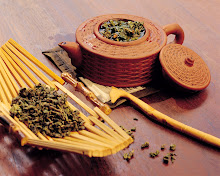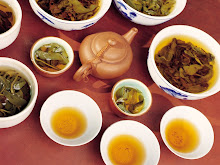The most common way to make wu long tea (also spelled oolong tea or oolong tea) is Gong Fu style. Making wu long tea this way requires a small earthenware teapot. The wu long is served in small cups, and the same oolong tea leaves can be brewed many times.
Making tea gong fu style is ideal for Taiwan wulong tea. The short brewing time allows the sweet flavor of the wulong tea to come out without excess caffeine or tannin. Even those who are sensitive to caffeine can drink this type of tea all evening and still get a good night’s sleep.
Water
When making tea of any sort high quality water is essential. This is especially true for Taiwan wu long tea because of the subtle flavors that are revealed through proper brewing techniques.
The best water for making wu long tea is spring water. If you don’t have access to spring water, you can improve tap water by letting the chlorine escape before making the tea. This is done by letting the water sit uncovered for 24 hours. Chlorine can also be removed by boiling the water for 5 minutes in an uncovered pot, but this method is not recommended for wu long tea because it makes the water flat.
Temperature
Water for making wulong tea should be just below the boiling point - about 85 - 95 degrees Celsius or 185 - 205 degrees Fahrenheit. Rather than measuring the temperature, try removing it from the heat when the large bubbles are just starting to form.
Utensils
A typical Taiwanese wu long tea set consists of an unglazed clay teapot, a serving pitcher, a strainer, several small ceramic tea cups, a scoop for putting the wu long leaves in the pot, and a tray to capture water. Tea towels can be useful for drying the bottom of cups before they are served, and prongs are used to remove used wu long tea leaves from the teapot.
Almost every household in Taiwan has this type of wu long tea set. The tray can be a simple round design made from stainless steel or an ornate decorative object made from carved wood or stone. Decorative trays have a drainpipe which leads to a small bucket underneath. Decorative trays for making oolong tea are prominently displayed and may even be integrated into a table top.
Method
-When the water has reached the correct temperature, a small amount is used to rinse the teapot and cups. wu long tea is then measured into the teapot - usually to about 1/4 or 1/3 of the volume of the teapot. The wu long tea leaves are not handled - a scoop is used to put the tea into the teapot.
-The teapot is filled about half-way with hot water. This first infusion is not for drinking - it allows the wulong tea leaves to “awaken” and start to unfurl. It also removes excess dust from the tea leaves.
-The teapot is swirled around to distribute the water evenly through the tea leaves and then poured out into the serving pitcher after about 10 seconds. The pot is immediately filled again for the first drinking infusion.
-As the tea is steeping the liquid from the serving pitcher is poured into the cups to heat them up. This water is then poured over the tea pot to draw steam through the hole.
The first steep is quite short - 30 to 50 seconds depending on the type and quality of the oolong. Making wulong tea is a delicate art and finding the appropriate balance between volume, temperature, and steeping time requires knowledge of the tea leaves. If the first steep is too strong or too weak, you can adjust the brewing time for subsequent steeps.
The wu long is poured through the strainer from the teapot to the serving pitcher and then to the individual cups. The cups are arranged next to each other and the pouring is done in a continuous circular motion. This allows each cup to receive wu long tea which is identical in taste and color.
The bottom of the cups are wet from the tray and the spillage so they should be briefly placed on the tea towel before serving.
After pouring the wu long tea the teapot can be immediately filled with hot water for the subsequent brew. Each brewing time can be slightly longer than the previous.
Monday, April 27, 2009
Subscribe to:
Post Comments (Atom)






No comments:
Post a Comment